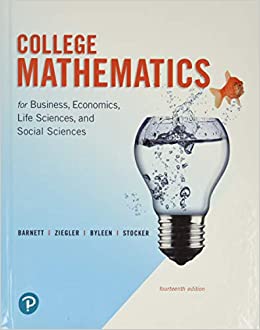Question
Radar Railway is determining whether to purchase a new rail setter, which has a base price of $432,000 and would cost another $52,000 to install.
Radar Railway is determining whether to purchase a new rail setter, which has a base price of $432,000 and would cost another $52,000 to install. The setter falls into the MACRS 3-year class, and it would be sold after three years for 220,000. Using the setter requires a $22,000 increase in net working capital. Although it would have no effect on revenues the setter should save the firm $185,000 per year in before-tax operating costs (excluding depreciation). Radar's marginal tax rate is 40% and its required rate of return is 14%. Should the setter be purchased? Explain.
Depreciaqtion
Year 1 - $159,720
Year 2 - $217,800
Year 3 - $72,600
 Business Finance Fall 2015 CHAPTER 9 1. Compute the (a) net present value, (b) internal rate of return, (c) payback period for each of the following projects. The firm's required rate of return is 14%. YEA R 0 1 2 3 PROJECT A PROJECT B $(270,000 ) 120,000 120,000 120,000 $(300,000 ) 0 (80,000) 555,000 Which project(s) should be purchased if they are independent? Which project(s) should be purchased if they are mutually exclusive? CHAPTER 10 2. Radar Railway is determining whether to purchase a new rail setter, which has a base price of $432,000 and would cost another $52,000 to install. The setter falls into the MACRS 3-year class, and it would be sold after three years for 220,000. Using the setter requires a $22,000 increase in net working capital. Although it would have no effect on revenues the setter should save the firm $185,000 per year in before-tax operating costs (excluding depreciation). Radar's marginal tax rate is 40% and its required rate of return is 14%. Should the setter be purchased? Explain. Depreciaqtion Year 1 - $159,720 Year 2 - $217,800 Year 3 - $72,600 3. Otter must decide whether to replace a 10 year-old packing machine with a new one that costs$153,800. Replacing the old machine will increase net operating income(excluding depreciation) from$70,000 to $110,000 and it will decrease net working capital by $18,000. The new machine falls into MACRS 5year class. If the new machine is purchased, it will be sold in 6 years for $25,000, whereas, if the old machine is kept, it will have no salvage value in 6 years. The old machine has a current market value of $10,860 and although its current book value is $8,000, in one year the old machine's book value will be zero ($0). The firm's marginal tax rate is 40% and its required rate of return is 12%. Should the new packing machine be purchased? Explain. Depreciation NEW OLD Year 1 -$22,760 $ 8,000 Year 2 - $49,216 $0 Year 3 - $29,222 $0 Year 4 - $18,456 $0 Year 5 - $ 16,918 $0 Year 6 - $9,228 $0
Business Finance Fall 2015 CHAPTER 9 1. Compute the (a) net present value, (b) internal rate of return, (c) payback period for each of the following projects. The firm's required rate of return is 14%. YEA R 0 1 2 3 PROJECT A PROJECT B $(270,000 ) 120,000 120,000 120,000 $(300,000 ) 0 (80,000) 555,000 Which project(s) should be purchased if they are independent? Which project(s) should be purchased if they are mutually exclusive? CHAPTER 10 2. Radar Railway is determining whether to purchase a new rail setter, which has a base price of $432,000 and would cost another $52,000 to install. The setter falls into the MACRS 3-year class, and it would be sold after three years for 220,000. Using the setter requires a $22,000 increase in net working capital. Although it would have no effect on revenues the setter should save the firm $185,000 per year in before-tax operating costs (excluding depreciation). Radar's marginal tax rate is 40% and its required rate of return is 14%. Should the setter be purchased? Explain. Depreciaqtion Year 1 - $159,720 Year 2 - $217,800 Year 3 - $72,600 3. Otter must decide whether to replace a 10 year-old packing machine with a new one that costs$153,800. Replacing the old machine will increase net operating income(excluding depreciation) from$70,000 to $110,000 and it will decrease net working capital by $18,000. The new machine falls into MACRS 5year class. If the new machine is purchased, it will be sold in 6 years for $25,000, whereas, if the old machine is kept, it will have no salvage value in 6 years. The old machine has a current market value of $10,860 and although its current book value is $8,000, in one year the old machine's book value will be zero ($0). The firm's marginal tax rate is 40% and its required rate of return is 12%. Should the new packing machine be purchased? Explain. Depreciation NEW OLD Year 1 -$22,760 $ 8,000 Year 2 - $49,216 $0 Year 3 - $29,222 $0 Year 4 - $18,456 $0 Year 5 - $ 16,918 $0 Year 6 - $9,228 $0 Step by Step Solution
There are 3 Steps involved in it
Step: 1

Get Instant Access to Expert-Tailored Solutions
See step-by-step solutions with expert insights and AI powered tools for academic success
Step: 2

Step: 3

Ace Your Homework with AI
Get the answers you need in no time with our AI-driven, step-by-step assistance
Get Started


